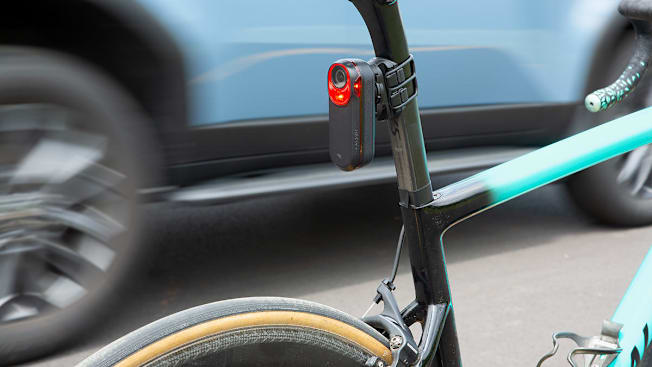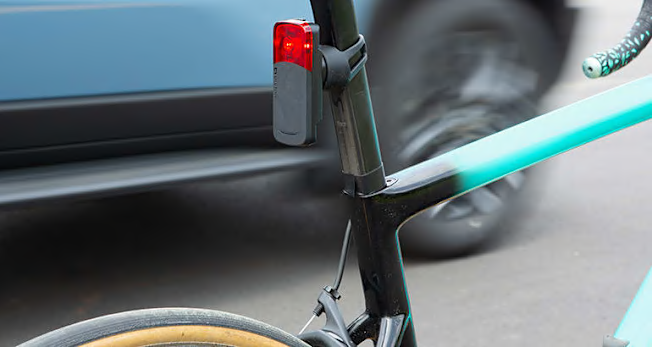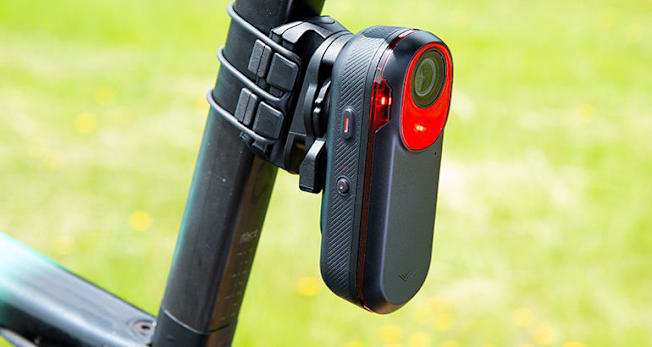Best Bike Radar Taillights
While a bright taillight can warn drivers about a cyclist ahead, these eight radar units are meant to warn the cyclist about approaching and overtaking vehicles
When you shop through retailer links on our site, we may earn affiliate commissions. 100% of the fees we collect are used to support our nonprofit mission. Learn more.
Most bicycle riders will inevitably end up sharing the road with motorized vehicles during some of their rides. This raises the risk of a collision, whether it’s on busy city streets or quieter rural roads. Studies have shown that using a blinking red taillight increases the odds that an approaching driver will see you and decreases the risk of your being hit.
But riders don’t have to just rely on the drivers to see them. A number of companies make taillights that incorporate radar that can alert a cyclist about approaching and overtaking vehicles. Audible and/or visual warnings are sent to a rider’s mobile phone or bike computer to give the rider the opportunity to prepare to be passed, as well as know how many vehicles are lined up behind them. Some of the better units issue a more urgent warning if the approaching vehicle is going particularly fast, and one of the devices we tested incorporates a camera that can record any incidents.
Riders who have a taillight on their bicycle are already at an advantage. Using a taillight on the back of a bicycle can improve safety by making riders more visible to drivers. A study of 3,845 cyclists conducted in Denmark in 2004 and 2005 found that riders with permanent lights mounted on their bikes had 19 percent fewer incidents than cyclists who rode without lights.
Whether you are on a casual family trip to a park or a multihour solo training session, using a radar taillight can give you more confidence and security about your surroundings. However, these devices don’t replace a cyclist being alert to their surroundings and shouldn’t lull them into a false sense of security. What they do best is to warn the rider when they should be on high alert.
The eight devices that we tested are (in alphabetical order) the Bryton Gardia R300L, Cyclami RT01, Garmin Varia RCT715, Garmin Varia RTL515, Garmin Varia RVR315, IGPSport SR30, Magene L508, and Trek CarBack.
What You'll Pay
Prices for our tested units ranged from $23 for a device that had a light and radar but didn’t connect to a phone or bike computer, up to $400 for one that incorporated a camera capable of taking video during the ride.
The majority of the units cost between $100 and $200. Sales and discounts are often available at certain times of year or when a newer version is released.
Best Bike Radar Taillights
Features to Look For
Taillights: One of the devices that we tested but don’t recommend, the Garmin Varia RVR315, is just a rear-facing radar unit. It does a very good job picking up cars and seeing them at an average of 450 feet behind the cyclist, and has a number of audible and visual warnings for the rider. But the RVR315 doesn’t have any warning for approaching drivers that a cyclist is ahead on the road. Riders who already have a light that they are satisfied with may be okay with using the RVR315, although that means the rider has two devices to keep charged up.
Device connection: Another radar unit we tested, the Cyclami RT01, is a radar taillight that incorporates a brake light feature. When the rider slowed, the device changed the brightness and pattern of the light to alert drivers. However, the RT01 doesn’t connect to a phone or bike computer, and therefore has no way of alerting the rider about approaching or overtaking vehicles. The RT01’s Overall Score is too low for us to recommend it.
Tether strap: Two of the devices we tested, the Bryton Gardia R300L and Magene L508, come with a strap that attaches to the device and the bicycle. These provide extra security to keep the radar from being lost if the device falls off during the ride.
Video capability: One reason the Garmin RCT715 scores at the top of our ratings is its ability to record video and take still images. It has a helpful incident detection mode, where it will record a clip and prevent it from being erased if an internal accelerometer determines the cyclist may have been in a crash—such as a rapid stop or the radar suddenly moving up or down. However, some drawbacks are that it’s slow to review the video clips in the app, the unit is bulky, it has a short battery life, and it’s expensive.
Video from the Garmin RCT715.
Waterproof rating: Aside from fair-weather cyclists (by choice or locale), bike riders run the risk of getting caught in wet weather or, at the least, riding through a puddle. Make sure that the device you choose has an IPX (ingress protection rating) that matches the type of conditions you ride in. For example, most of the devices we tested have an IPX7 water rating, which means they are protected against water immersion for 30 minutes up to a depth of 1 meter. This means you can use the radar taillight in a rainstorm without worry about water getting inside.
Braking: A few of the devices can change the light pattern or intensity to catch the eye of a driver behind, so they recognize that the cyclist is slowing down. This may be more useful when riding with friends because the temporary increase in brightness can be explained beforehand. Drivers may not realize the brighter light or change in pattern means the cyclist is slowing. Still, any warning that can alert a driver is useful.
What You'll Need
Phone or cycling computer: To take advantage of the benefits of the radar, a cyclist will need to pair the radar-taillight either to their cell phone or a bike computer (the units only pair with one device at a time). Nearly every radar we tested will pair with an Android or iOS app, as well as a wide variety of cycling computers and sports watches. Riders can then receive audible and visual alerts, including how many vehicles are approaching, on their phone or bike computer. More performance-oriented cyclists may buy a cycling-specific computer, which can range from $55 to $700. A cell phone mount can cost between $6 and $60.
Handlebar mount: Riders planning to use their cell phone to display connections to the radar will need to buy a mount to secure their phone to their handlebars. Most cycling computers should include a handlebar or stem mount as part of the purchase.
Most of the radar units send an audible alert in addition to the visual alert. This makes it possible for a cyclist to keep their phone in a pocket and just listen for the audible warnings rather than rely on the display. It could be hard to hear the beeps in a loud environment, like a city. And wearing earbuds or headphones to better hear the alerts when riding is not safe.
Extra seat post mounts: Riders who plan to use the radar taillight on different bikes or share it with members of their family should consider buying additional seat post mounts. These make it easier to attach the device and go rather than fumbling around with different rubber inserts or stretching the rubber straps by taking the mount on and off different bikes. Extra mounts range between $20 and $40.
How CR Tests Bike Radar Taillights
We evaluated radar distance by mounting the bike radar on a tripod. The test was performed on a straight, unoccupied road using a 2017 Honda Civic as the test vehicle. Communication between the driver and the tester, positioned near the radar and monitoring an iPhone 11 application, was maintained via telephone. Immediately upon radar detection of the approaching vehicle, the tester notified the driver. The driver then halted the vehicle, and the distance between the radar and the vehicle was measured and rounded to the nearest 5 feet. This procedure was replicated three times for each model, and the results were averaged.
Versatility Score Considerations
• Does the device have a camera? (physical storage type; cloud storage for video)
• iOS app support?
• Android app support?
• Is the device compatible with a bike computer?
• Does the device have a physical indicator that the battery is charging?
• Does the device have a physical indicator that the battery is low?
Vehicle Warning Score Considerations
• Taillight
• Brake light
• Unique alert for approaching vehicles
• Number of light modes
Rider Warning Score Considerations
• Provides visual alerts to the rider
• Provides audible alerts to the rider
• Provides audible alerts when the app is running in the background
• Indicates the approaching vehicles’ distance and lane relative to the bike
• Visual distinction between close and distant vehicles



























